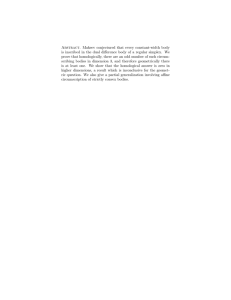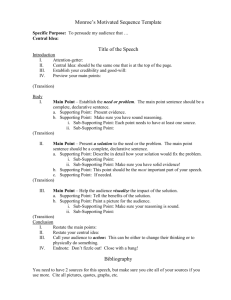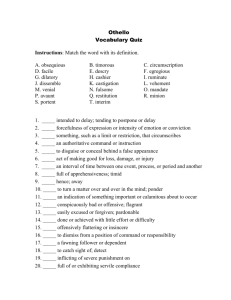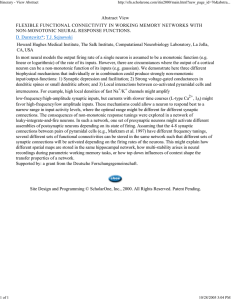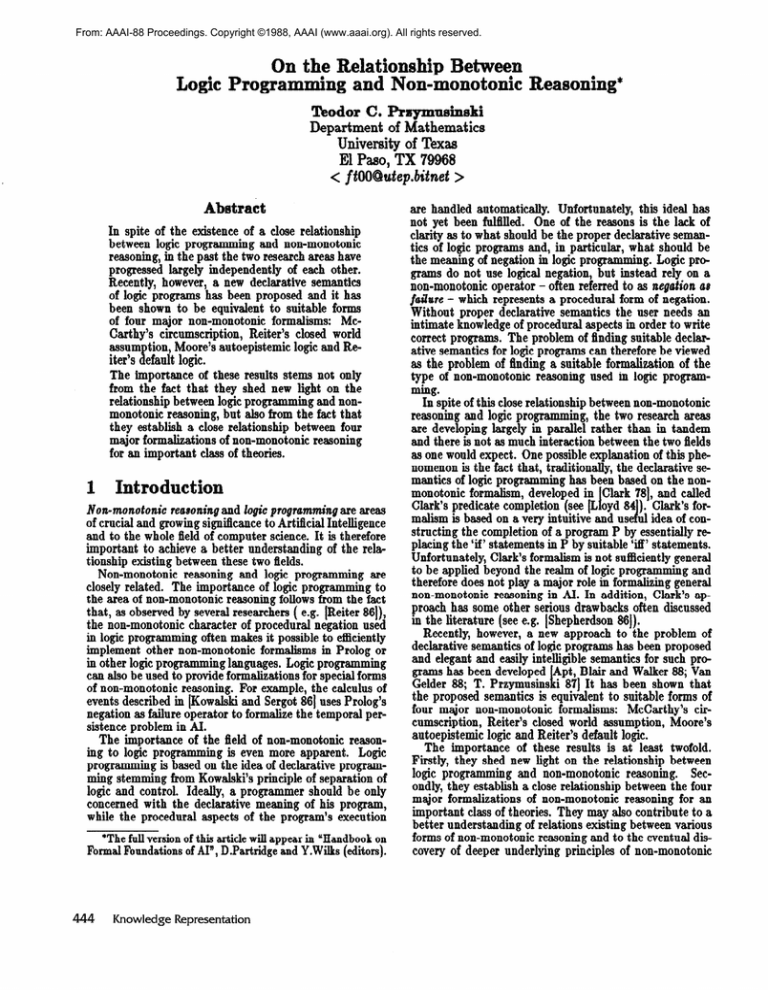
From: AAAI-88 Proceedings. Copyright ©1988, AAAI (www.aaai.org). All rights reserved.
On the Relationship Between
Logic Programming and Non-monotonic Reasonin
TeOdOP
6. Rsymll8inshi
Department of Mathematics
University of Texas
El Paso, TX 79968
< ftOO0utepbitnet >
Abstract
In spite of the existence of a close relationship
between logic programming and non-monotonic
reasoning, iu the past the two research areas have
progressed largely independently of each other.
Recently, however, a uew declarative semantics
of logic programs has been proposed and it has
been shown to be equivalent to suitable forms
of four major non-monotonic formalisms: MCCarthy’s circumscription, Reiter’s closed world
assumption, Moore’s autoepistemic logic and Reiter’s default logic.
The importance of these results stems not ouly
from the fact that they shed new light on the
relationship between logic programming and uoumonotonic reasoning, but also from the fact that
they establish a close relationship between four
m8jor forma&&ions of non-monotouic reasoning
for au importaut class of theories.
Non-monotonic reaaoaing and logic pro~?~~~‘~g are areas
of crucial and growing significance to Artificial Intelligence
and to the whole field of computer science. It is therefore
important to achieve a better understauding of the rele
tiouship existing between these two fields.
Non-monotonic reasoning and logic programming are
closely related. The importance of logic programming to
the area of non-monotonic reasouiug follows from the fact
that, as observed by several researchers ( e.g. (Reiter 86)),
the non-monotonic character of procedural uegatiou used
in logic programming often makes it possible to efllcieutly
implement other non-monotonic formalisms in Prolog or
iu other logic programming languages. Logic programming
cau also be used to provide formalizations for special forms
of non-monotonic reasoning. For example, the calculus of
events described in (Kowalski aud Sergot $61 uses Prolog’s
negation as failure operator to formalize the temporal persistence problem in AL
The importance of the field of non-monotonic reasouiug to logic programming is even more apparent. Logic
programming is based on the idea of declarative programming stemming from Kowalski’s principle of separation of
logic and control. Ideally, a programmer should be only
concerned with the declarative meaning of his program,
while the procedural aspects of the program’s execution
*The full version of this article will appear in “Handbook on
Formal Foundations of AI”, D.Partridge and U.Wilks (editors).
444
Knowledge Representation
are handled automatically. Unfortunately, this ideal has
not yet been ffilfilled. One of the reasous is the lack of
clarity as to what should be the proper declarative semautics of logic programs and, in particular, what should be
the meaning of negation in logic programming. Logic programs do not use logical negation, but instead rely ou a
non-monotonic operator - ofieu referredto as negation uu
juih? - which represents a procedural form of negation.
Without proper declarative semantics the user needs au
intimate knowledge of procedural aspects iu order to write
correct programs. The problem of finding suitable declarative semautics for logic programs can therefore be viewed
as the problem of finding a suitable formalization of the
type of non-monotonic reasouiug used iu logic programming.
In spite of this close relationship betweeu non-monotonic
reasoning and logic programming, the two research areas
are developiug largely in parallel rather th
in taudem
aud there is not as much interaction between the two fields
as one would expect. One possible explanation of this phenomenon is the fact that, traditionally, the declarative semantics of logic programmiug has been based on the uoumonotonic formalism, developed in Clark 781, and called
Clark’s predicate completiou (see [L1oyd 84 ). Clark’s formalism is based on a very intuitive and usa ul idea of coustructiug the completion of a program P by essentially replacing the ‘if’statements iu P by suitable ‘ifl”statements.
Unfortunately, Clark’s formalism is not suflfcieutly general
to be applied beyond the realm of logic programmiug and
therefore does not play a major role iu formalizing general
non-monotonic reasoning in AI. In addition, Clark’s approach has some other serious drawbacks often discussed
iu the literature (see e.g. [Shepherdson 861).
Recently, however, a new approach to the problem of
declarative semautics of logic programs has been proposed
and elegant and easily intelligible semautics for such programs has been developed Apt, Blair and Walker 88; Vau
Gelder 88; T. Przymusins ki 87) It has been shown that
the proposed semantics is equivalent to suitable forms of
four major non-monotonic formalisms: McCarthy’s circumscription, Reiter’s closed world assumption, Moore’s
autoepistemic logic aud Reiter’s default logic.
The importance of these results is at least twofold.
Firstly, they shed new light on the relationship between
logic programming and non-monotonic reasouiug. Secondly, they establish a close relationship between the four
major formalizatious of non-monotonic reasoning for an
importaut class of theories. They may also contribute to a
better understanding of relations existing between various
forms of nou-monotonic reasoning and to the eventual discovery of deeper underlying principles of non-monotonic
reasoning. The aim of this paper
of these recent developments.
is to present
au accost
In [Apt, Blair and Walker 881 and [Van Gelder 88 au importaut class of ~~~t~~~ Z&c p~~~rn~ ww intro duced, a
unique ‘natural’ minimal Werbrand model Mp of a stratified logic program was defined aud it was argned that this
model may be taken to represent the declarative semautics
of such programs.
In [T. Przymusinski 881 aud [T. Przymus~s~ 87 the
class of perfect model8 of a logic program was defined!aud
it was shown that every stratifled logic program h
actly oue perfect Herbmad model which coincides wi
model 131~. The perfect model sematatice of logic rograms
is the semautics determined by the class PERF PP) of all
ecessarily Herbrand) perfect models of a program
first introduce the Ieperu%encygraph G of the program P whose vertices are predicate symbols occurriug in
P. If A and B are predicate symbols, then there is a dia
rected edge iu G from B to A if and only i
of
clause iu P such that A occurs iu its head and
is
its premises. If this premise is negative, then
called nqatiate. For any two predicate symbols iu P we say
that B bat lower priority thar%A (briefly, B < A if there
is a directed path in 6: leading from I3 to A an d passing
through at least one negative edge. We call the relatiou
defined above the priority teMon IT. Przymusiuski $71.
e now deflue the notiou of a perfect model. It is our
god to ti92Mze eztendonrrof low priority predicates a8
march a8 podble, and we are willing to do that even at
the cost of enlarging extensions of predicates with higher
priority. Consequently, if M is a model of P and if a new
model N is obtained from M by changing exteusious of
some predicates in M, then we will consider the uew model
N to be referable to M if aud only if additiou of some new
element Qs) to the extension of a higher priority predicate
A is always g’ustti/ied
by the simultaneous removal
elements from the extension of a lo
i.e. such that B < A. A model M w
if there are no models preferable to 1
Definition. [T. Przymusiuski 87) Suppose that
N are two distinct models of a general program P,
M
with the same universe aud the same interpretation of fuucs) and denote by EM A) aud EN(A)
tious (and cons
the extensions i
aud N, respectively, oc a predicate A.
ejerable to M briefl , EB4 Ad), if for
We say that N
every predicate A for which the set !EN(A3 -.&(A) is nonempty there is a predicate symbol B < A such that
is non-empty. We say that a mod
&@)-.&(B
P is perfect if t here are no models preferable to M.
the relation 4 the preference relation between models aud
FN, if M=N or M 4 N.
[T. Przymusinski 871 Every perfect
Theorem.
For positive1 logic programs the converse is true.
[T. Przymusiuski 871If M is a model
“Aprogmmis positive
if it does not have negative
every clause
in P, where A’s, ‘s and C are atoms, we
(i) for every i, stratum(A() 5 stratum(@),
(ii) for every j, stratum&) < stratum(C),
where stratum(A)=i, if the predicate symbol of A belongs to Si. Any particular decomposition (Si , ... , $1
of S satisfying the above couditious is c ed a ~t~~~~~t~o~
.
a unique perfect Berbrand model which coiucides with the
model A&.
Now we define the perfect model semantics of a logic
program.
mini& model semanticg i.e. to the semautics iuduced by
the class MN P of all - not necessarily Merbraud - minimal models oId . The perfect model semanticr in ho
than the semantice defined by Chrk’~ completion co
of the program P i.e. for auy sentence F, if comp(P
then PERF(P) b F. Nowever, as the following example
indicates, the perfect model semantics eliminates some of
the uniutuitive features of Clark’s semautics.
Przymusinslti
45
le. (Van Gelder). Suppose, that we
wanted to describe which vertices in a graph are reachable from a given vertex a. We could write
edge(a, b)
redzub~e(ca)
reackubZe(X)
unreuchubb(X)
f&h+, 4
t
c-
fG$.k 4
recschab~e( Y ) , e&e( Y, X)
preachable.
This seems to be a very reasonable program and we certainly can expect vertices c and d to be unreachable from a.
Rowever, Clark’s completion of P lacks the power to derive
these conclusions [T. Przymusiuski 871. On the other Baud,
it is easy to verify that the program is stratified by a stratiflcatiou S~=(reachable, edge} and Ss=(unreachable) and
that the perfect model semautics provides the correct auswers.
In T. Przymusinshi 871 SLS-tesodcrtion(Linear terrolrtiora
witI Selection jmctiow jot Stratified p~grarnu) wm de-
fined and it was shown that SLS-resolution is souud and
complete (for non-flouuderiug queries2) w.r.t. the perfect model sexnadics and therefore provides a procedural
mechanism for the proposed semantics. SLS-resolution is
a natural generulkdion of SLD-resolution (Linear resolution with Selection function for Definite programs from
the class of positive (definite) programs onto the c1ass of
stratifled programs. SLS-resolution differs from SLDNFresolution primarily by not relying on finite failure trees.
3. Theorem.
(Soundness of $LS-~3olMt~on)
Suppose that P is a stratified program aud G =+ Ff’is a
goal. Then
(i) If 8 is any SLS-auswer-substitution,
then
PERF(P) + we
(ii) If SLS-tree for G is frailed, then PERF(P) + +V .
(Completeness
of SLSTheorem.
Suppose that P is a stratified program, G =+
W is a non-floundered goal and 0 is a substitution. Then
(i) PERF(P)
b WO iff there exists au SLS-auswersubstitution more general than 8;
(ii) PERF(P) k 4V iff SLS-tree for G is failed.
In the special case when P is a positive program, SLSresolution reduces to the staudard SLD-resolution. Theorem 2.10 therefore implies au important result showiug
that for positive goals SLD-retoltltioa i8 80tltaa and com-
2.10.
resolution)
plete w.t.t. the minimal m0dei semantic8.
In this section we show that the perfect model semantics for logic programs described in the previous section
is (semantically) equivalent to suitable forms of four major
non-monotonic formalisms: (1) circumscription, (2) closed
world assumption, (3) autoepistemic logic and (4) default
logic.
These results provide a further argument iu favor of
the perfect model semantics and underscore the relatiouship between logic programming and non-monotonic reasoning. They should also contribute to a better understanding of the relation existiug between various forms of
non-monotonic reasoning.
One of the most powerful formalizations of non-monotonic
riptiou, was introduced iu [MCThe following theorem estabeeu the perfect model semautics
of logic programs and the semantics of prioritized circumscription. A similar result for poiutwise circumscription
was obtained in Lifschitz EM]and related results were obtained earlier in 1Reiter $21.
.1. Theorem. (T. Przymusiuski 871 Suppose that P
is a stratified program and Sl,...,& is a stratification of
P. A model of P is perfect if and only if it is a model of
prioritized circumscription CIRC(P;Sl > ... > Sn . Consequently, the perfect model semantics of P coincides with
the semautics of prioritized circumscription of P, i.e. for
any sentence F
PERF(P)
b F a
cmcp;
Sl > . .. > SR) /= F.
The above theorem has two interesting cousequences:
Siuce SLDNF-resolution used iu Prolog is sound w.r.t.
the perfect model semautics it is also sound w.r.t.
to the semantics of prioritized circumscription. This
means that SLDNF-resolution can be used as a sound
iufereuce engine for some types of circumscriptiona.
rms Reiter’s comment that ‘partly
because it is a non-monotonic operator, procedural
negation cau often be used to implement other forms
of non-monotonic reasoning [Reiter $61.
In general, it is not clear how to instautiate the circumscription axiom in order to derive the desired consequences of a circumscribed theory. The equivalence
between the perfect model semantics aud prioritized
circumscription shows that iu the case of stratifled
logic programs such au instautiatiou cau be generated
automatically based on the syntactic form of the program*
(a88
ptim
An alternative way to formalize non-monotonic reasoniug
is to use some form of the closed world assumption. The
first step in this direction was made by Reiter, who dellned
the so called n&e cfooare CWA(P) of a theory P:
3.3.
efln1t10n.
(Reiter 78) The n&e closarre
CWA(P) of P is defined as follows:
OVA(B)
= P
u
(1~:
p is a ground atom and P p p>.
Reiter’s CWA(P), although suitable for positive programs, is usually inconsistent for programs with negative
aA query answering algorithm for general circumscriptive
‘See [Lloyd 841.
Knowledge
Representation
theories has been described in IT. PrzynuGnski 8’?a].
premises. FOP example, if P is p + lq, then CWA(P)
implies lp and lq and is inconsistent.
Stimulated by Reiter’s work, several researchers proposed more sophisticated forms of the closed world assumption, namely the Generalized Closed World Assumption [Minker $21, the Extended Closed World Assumption (Gelfond, II. Przymusinska and T. Przymusinski Ma;
Yahya asd Hewchen SS] and - the most general of them
Iterated Closed World Assumption (
Przymusinska and T. Przymusinski
simplified definition of ICWA, whit
for logic programs.
.a. ~@~~I~~o~. [Moore 801 A set of formulae E(T)
is a odeMeat&egi&emic ezpamuoo;r of T if it satisfies the
following fixed point condition:
E(T) = Th(Tu
(Lp : p E E(T)}
u (l&p : p
where p is a propositional formula.
To establish a relationship between perfect model spa
mantics and autoepistemic logic we have to define an interpretation of propositional formulae in terms of autoepistemic beliefs.
nMon. [Gelfond 781 For any propositiond
ia
e interpretation I(F) of F is obtaimd by refo
placing every occurrence of a negative literal -p h F by the
literal -&p. For a logic pro
set Of al1 autoepistemic
l
e following theorem shows that - under the above
interpretation - autoepistemic logic is semantic
alent to the perfect model semantics. It has been shown
ICWA(F$;
27,) = CWA(P~);
ICWA(Pn+I;Sl
= CWA(P,,,
ICWA(P;&.
I
+ ICWA(P,;
> . . . > Sn+l) =
Sl > .s. > Sn)), for ra > 0,
> e.. > Sk) = ICWA(Bk;Sl
> .. . > Sk).
following theorem shows that the semabntics of
> Sk) is equivalent to the perfect model
S
Theomm (Gelfond, . Przymusinska and T.
mu&&i %a] Assume the domain closure axiom and suppose that P is a stratifled logic program aud S1,...,Sk is
a stratification of P. The theory ICWA(P;Sl > .. . > Sk)
has exactly one model and this model is the unique perfect
model of P.
The above theorem provides a syntactic description of
the perfect model semantics in the form of a first order
theory. It generalizes an earlier result obtained for positive
programs and minimal models (Lifschitz 851.
in Moore 801 pro830I! non-monotonic
reasoning. Moore uses modal logic to form
oniug about his knowledge or bellieffi.
oore and consider here propositional th
I3y an autoepistemic theory T we mean a set of formulae in the lmguage of propositional calculus augmented by
a belief operator L, where, for any formula F, LF is interpreted as ‘I? is believed’. The set of all propositional
consequences of T will be denoted by Th(T).
The centraJ role in Moore’s formalization is p
the notion of a stable autoepistemic expansion of
intuitively represents a possible set of beliefs of an ideally
rational age&. The agent is ideaIly rational in the sense
that he believes in all and only those facts which he can
conclude from T and from his other beliefs. If this expansion is unique then it can be viewed as the set of theorems
which follow from T in the abutoepi&eHlraic
bgic.
orem underscores an important feature
of autoepidemic logic, namely the fact that in order to
obtain equivalence with the perfect model semantics, it is
raotnecessary to introduce the concept of prioritization into
autoepistemic logic as it was the case with circumscription
and the closed world assumption. In a seuse, ~rio~tizatio~
is already built iuto autoepistemic logic.
circumscription, the above theorem
esolution can be used as a sound
r a class of autoepistemic theories.
w of the fact that autoepi
non-constructively and no psoc
to derive its theorems.
Another approach to the formalization of non-monotonic
reasoning was proposed iu
logic. Its d~tin~ish~g fe
fault statements which functiou as addI
fereuce rather than formulae iu some theory.
A (closed) ~efu~2~fde R is a rule of the form
Q : Mbl, ...) Mb,
c
Przymusinski
447
5.9. DefInitfon [Reiter 801Suppose that < D, T > is a
default theory. For any set S of first order sentences define
G S) to be the smallest set (it always exists!) with the
fo6owing properties:
(i) T is contained in G(S);
(ii) G(S) is closed under logical consequence;
(iii) if B is a rule from D of the above described form)
and if a is in G(S) an , for every i, + is not in S,
then c is in G(S).
Any set of first order sentences E satisfying E=G(E) is
called an ezfekon of < D, T >, i.e. extensions are fixed
points of the operator G.
A default theory < D, T > may have none, one, or more
than one extension. Any such extension is a possible set of
beliefs for an agent. If the theory has exactly one extension
E, then E can be considered as the set of theorems of <
[Gelfond, H. Przymnsinska and T. Przymusinshi SSa]
Gelfond, hf., Przymusinska, H. and Przymusinskr, T., ‘On
the Relationship between Circumscription and Negation as
Failure’, ArtificiaI Intelligence, to appear.
[Konoiidge 87) Konoiige, K., ‘On the relation between default
theories and autoepistemic logic’, SRI International, 1987,
draft paper.
D,T >.
[Lloyd 841 Lloyd, J.W., Foundations of Logic Programming,
Springer-Veriag 1984.
In [Bidoit and Froidevaux 861 it was shown that the
perfect model semantics of a stratified logic program P
is equivalent to a suitable default theory generated by P.
Suppose that P is a logic program. Denote by T the set
of all positive clauses of P and by D the set of defaults
obtained as follows: for any clause
[McCarthy 801 McCarthy, J,, ‘Circumscription - a Form of
Non-Monotonic Reasoning’, Artificial InteUigence 13(1980),
27-39.
/McCarthy 861 McCarthy, J., ‘Applications of Circumscription
to Formalizing Common Sense Knowledge’, J. Artificial Intelligence 28(1986), 89-116.
in P such that ~a> 0, include in D the default rule:
: MIB1,
C
. .. . MlB,
and call the resulting default theory < D, T > the defotat
tbeot# aeroci~bed widft the program P.
3.10. Theorem,
Bidoit and Froidevaux 86 Suppose
that P is a strattied Iogic program and < D, Ir > is the
associated default theory. The theory < D,T > has exactly one extension E and the unique minimal model of E
is the unique perfect model of P.
The above approach is similar to that used in the case of
autoepistemic logic, which is not surprising in view of the
close relationship existing between default and autoepistemic logics [Konolidge 871.
References
[Apt, BIair and WaIker 88 Apt, K., Blair, H. and WaIker, A.,
‘Towards a Theory of d eclarative Knowledge’, in: Foundations of Deductive Databases and Logic Programming, (ed.
J.Miuker), Morgan Kaufmaun 1988,890148.
[Bidoit and I%oidevaux 86) Bidoit, N. and Froidevaux, Cl.,
%Iinimalism Subsumes Default Logic and Circumscription
in Stratified Logic Programming’, preprint, 1986.
[Bossu and Siegel 851 Bossu, G. and Siegel, P., ‘Saturation,
Nonmonotonic Reasoning and the Closed World Assnmp
tion’, Artificial InteIIigence 25( 1985), 13-03.
[Clark 78 Clark, K.L., ‘Negation as F&lure’, in: Logic and
Data Elases (H.GaIlaire and J.Minker, Eds.), Plenum Press,
New York 1978, 293-322.
[Geifond 78) Geifond, M., On Stratified Autoepistemic
ries, Proceedings AAAE87.
Theo-
[GeIfond and H. Przymusinska 861 Gelfond, M. and Przymusinslra, H., ‘Negation as Failure: Careful Closure Procedure’,
Artificial Intelligence 30( 1986), 273-287.
448
Knowledge Representation
(Lifschite 851 Liischita, V., ‘Closed World Data Bases and Circumscription’, Artificial Intelligence 27( 1985), 229235.
[L&chits 881 Lifschitz, V., ‘On the Declarative Semantics of
Logic Programs with Negation’, in: Foandations of Deductive Databases and Logic Programming, (ed. J.Minker),
Morgan Kaufmaun 1988, 177-192.
pinker 82 Minker, J., ‘On Indefinite Data Bases and the
Closed a orId Assumption’, Proc. 6-th Conference on Automated Deduction, Springer Verlag, 1982,292-308.
C + Al, . . ..Am. lB1, . . . . lB,,
A1 A 1.. A A,
[Kowaiski and Sergot 861 Kowalski, R. and Sergot, M., ‘A
Logic-based Calculus of Events’, New Generation Compathg 4(1986), 67-95.
[Moore 801 Moore, ICC., ‘Semantic Considerations on Nonmonotonic Logic’, Artificial Intelligence 25( 1985), 75-94.
[H. Przymusinska 871 Przymusinska, H., ‘ On the Relationship between Autoepistemic Logic and Circumscription for
Stratified Deductive Databases’, Proceedings of the International Symposium on Methodologies for IntelIigent Systems,
Knoxville 1987.
[T. Przymusinski 871 Przymusinski, T., ‘On the Declarative
and Procedural Semantics of Logic Programs’, to appear.
[T. Przymusinski 87a] Przymusinski,
Compute Circumscription’, A&&I
T., ‘An Algorithm to
Intelligence, to appear.
[T. Przymusinski 881 Przymusinski, T., ‘On the Declarative
Semantics of Stratified Deductive Databases and Logic Programs’, in: Foundations of Deductive Databases and Logic
Programming (ed. J.Miuker), Morgan Kaufmann 1988, 193216.
[Reiter 781 Reiter, R., ‘On Closed-World Data Bases’, in: Logic
and Data Bases (H.GaBaire and JMinker, Eds.), Plenum
Press, New York 1978, 55-76.
[Reiter 80) Reiter, R., ‘A Logic for Default Theory’, ArtificiaI
InteIIigence 13(1980), 81-132.
[Reiter 821 Reiter, R., ‘Circumscription implies Predicate
Completion (sometimes)‘, Proc. AAAI-82, 1982, 418-420.
[Reiter 861 Reiter, R., ‘N onmonotonic Reasoning’, Annual Reviews of Computer Science, to appear.
[Shepherdson 861 Shepherdson, J., ‘Negation in Logic Programming’, J. Logic Programming, to appear.
pan Gelder 881 Van Gelder, A., ‘Negation as Failure Using
Tight Derivations for General Logic Programs’, in: Foundations of Deductive Databases and Logic Programming, (ed.
J.Miuker), Morgan Kaufmann 1988, 149-176.
[Yahya and Henschen 85) Yahya, A. and Henschen, L., ‘Deduction in Non-Horn Databases’, Journal of Automated Reasoning 1(2)(1985),141-160.

